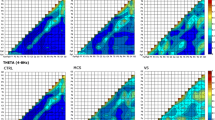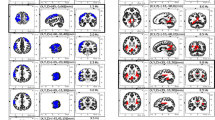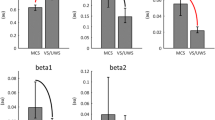Abstract
The specific features of the topology of spectral powers and coherent interregional interrelationships in the narrow, individually determined δ-, θ-, α1-, α2-, and α3-frequency bands were studied by means of high-resolution EEG (62 channels) in novice and experienced meditators (NMs and EMs) at rest and under the conditions of generation of an altered state of consciousness characterized by inactivation of cognitive activity and the occurrence of a positive emotional experience of happiness. EMs in the meditation-free state were found to be characterized by a shift in the values of the individual α frequency to a lower-frequency region of the spectrum, along with higher, compared to NMs, θ-, α1-, α2-, and α3-band power values, which probably reflects the cumulative character of the influence of long-term meditative practice. The effective achievement of altered states of consciousness in EMs was associated with an increase in the local θ- and α1 powers in the anterior cortical areas, as well as long-distance coherence between the prefrontal and posterior associative cortex with the formation of a center of gravity in the left prefrontal region (lead AF 3). According to the data of the correlation analysis of the EEG power values and the data of subjective scaling of the meditation state, the θ-power values were positively associated with positive emotional experiences and negatively associated with the level of mental activity. The results of this study are consistent with current concepts that the θ and α activities in narrow frequency bands reflect the activity of multifunctional neuronal networks selectively associated with processes of cognitive and affective activity.
Similar content being viewed by others
REFERENCES
Lou, H.C., Kjaer, T.W., Friberg, L., et al., A 15 O-H 2 O PET Study of Meditation and the Resting State of Normal Consciousness, Hum. Brain Mapp., 1999, vol. 7 (2), p. 98.
Travis, F. and Pearson, C., Pure Consciousness: Distinct Phenomenological and Physiological Correlates of "Consciousness Itself," Int. J. Neurosci., 2000, vol. 100, p. 77.
Newberg, A., Alavi, A., Baime, M., et al., The Measurement of Regional Cerebral Blood Flow during the Complex Cognitive Task of Meditation: A Preliminary SPECT Study, Psychiatr. Res., 2001, vol. 106 (2), no. 10, p. 113.
Gaylord, C., Orme-Johnson, D., and Travis, F., The Effects of the Transcendental Meditation Technique and Progressive Muscle Relaxation on EEG Coherence, Stress Reactivity, and Mental Health in Black Adults, Int. J. Neurosci., 1989, vol. 46, nos. 1, 2, p. 77.
Panjwani, U., Gupta, H.L., Singh, S.H., et al., Effect of Sahaja Yoga Practice on Stress Management in Patients of Epilepsy, Indian J. Physiol. Pharmacol., 1995, vol. 39 (2), p. 111.
Lee, M.S., Bae, B.H., Ryu, H., et al., Changes in Alpha Wave and State Anxiety during ChunDoSunBup Qi-Training in Trainees with Open Eyes, Am. J. Clin. Med., 1997, vol. 25 (3, 4), p. 289.
Infante, J.R., Torres-Avisbal, M., Pinel, P., et al., Catecholamine Levels in Practitioners of the Transcendental Meditation Technique, Physiol. Behav., 2001, vol. 72 (1, 2), p. 141.
Han, W., Zhang, L., and Xia, Y., The Difference in EEG Theta Waves between Concentrative and Nonconcentrative Qigong States-A Power Spectrum and Topographic Mapping Study, J. Tradit. Chin. Med., 1994, vol. 14 (3), p. 212.
Istratov, E.N., Lyubimov, N.N., and Orlova, T.V., Dynamic Features of Altered States of Consciousness in Transcendental Meditation, Byull. Eksp. Biol. Med., 1996, no. 2, p. 128.
Arambula, P., Peper, E., Kawakami, M., and Gibney, K.H., The Physiological Correlates of Kundalini Yoga Meditation: A Study of a Yoga Master, Appl. Psychophysiol. Biofeedback, 2001, vol. 26 (2), p. 147.
Kubota, Y., Sato, W., Toichi, M., et al., Frontal Midline Theta Rhythm Is Correlated with Cardiac Activities during the Performance of an Attention-Demanding Meditation Procedure, Brain Res. Cogn. Brain Res., 2001, vol. 11, p. 281.
Khare, K.S. and Nigam, S.K., A Study of Electroencephalogram in Meditators, Indian J. Physiol. Pharmacol., 2000, vol. 44 (2), p. 173.
Kamei, T., Toriumi, Y., Kimura, H., et al., Decrease in Serum. Cortisol during Yoga Exercise Is Correlated with Alpha Wave Activation, Percept. Mot. Skills, 2000, vol. 90, no. 3, part 1, p. 1027.
Delmonte, M.M., Electrocortical Activity and Related Phenomena Associated with Meditation Practice: A Literature Review, Int. J. Neurosci., 1984, vol. 24 (3, 4), p. 217.
Travis, F.T., Eyes Open and TM EEG Patterns after One and after Eight Years of TM Practice, Psychophysiology, 1991, vol. 28, no. 3 (a), p. 58.
Mason, L.I., Alexander, C.N., Travis, F.T., et al., Electrophysiological Correlates of Consciousness during Sleep in Long-Term Practitioners of the Transcendental Meditation Program, Sleep, 1997, vol. 20 (2), p. 102.
Lyubimov, N.N., EEG and Evoked Potentials Changes with the Use of a Special Form of Psychological Training (Meditation), Fiziol. Chel., 1999, vol. 25, no. 2, p. 56.
Travis, F. and Wallace, R.K., Autonomic and EEG Patterns during Eyes-Closed Rest and Transcendental Meditation (TM) Practice: The Basis for a Neural Model of TM Practice, Conscious. Cogn., 1999, vol. 8 (3), p. 302.
Travis, F., Tecce, J.J., and Guttman, J., Cortical Plasticity, Contingent Negative Variation, and Transcendent Experiences during Practice of the Transcendental Meditation Technique, Biol. Psychol., 2000, vol. 55 (1), p. 41.
Fedotchev, A.I., Bondar', A.T., and Akoev, I.G., Rhythmic EEG Structure of Humans: Present-Day State and Study Trends, Usp. Fiziol. Nauk, 2000, no. 3, p. 39.
Sviderskaya, N.E. and Korol'kova, T.A., Spatial Organization of Electrical Brain Processes: Problems and Solutions, Zh. Vyssh. Nervn. Deyatel., 1997, vol. 47, no. 5, p. 792.
Harmony, T., Fernandez, T., Silva, J., et al., Do Specific EEG Techniques Indicate Different Processes during Mental Calculation?, Neurosci. Lett., 1999, vol. 266, p. 25.
Klimesch, W., EEG Alpha and Theta Oscillations Reflect Cognitive and Memory Performance: A Review and Analysis, Brain Res. Rev., 1999, vol. 29, p. 169.
Doppelmayr, M., Klimesch, W., Pachinger, T., and Ripper, B., Individual Differences in Brain Dynamics: Important Implications for the Calculation of Event-Related Band Power, Biol. Cybern., 1998, vol. 79, p. 49.
Doppelmayr, M., Klimesch, W., Schwaiger, J., et al., Theta Synchronization in the Human EEG and Episodic Retrieval, Neurosci. Lett., 1998, vol. 257 (1), no. 20, p. 41.
Rai, U.C., Medical Science Enlightened. Life Eternal Trust, London-New York, 1993
Khanin, Yu.L., Cross-Cultural Perspectives of the Diagnosis of Individual Differences: Methodological and Conceptual Problems: Vopr. Psikhol., 1989, no. 4, p. 118.
Spielberger, C.D., Gorsuch, R.L., Lushene, R., et al., Manual for the State-Trait Anxiety Inventory, Palo Alto, CA: Consulting Psychologists Press, 1983
Bagby, M., Parker, J.D.A., and Taylor, G.J., The Twenty-Item Toronto Alexithymia Scale-I. Item Selection and Cross Validation of the Factor Structure, J. Psychosom. Res., 1994, vol. 38, p. 23.
Hanin, Yu., Eysenck, S.B.G., Eysenck, H.J., and Barrett, P., A Cross-Cultural Study of Personality: Russia and England, Person. Individ. Differ., 1991, vol. 12, p. 265.
Semlitsch, H.V., Anderer, P., Schuster, P., and Presslich, O., A Solution for Reliable and Valid Reduction of Ocular Artifacts Applied to the P300 ERP, Psychophysiology, 1986, vol. 23, p. 695.
Severtsen, B. and Bruya, M.A., Effects of Meditation and Aerobic Exercise on EEG Patterns, J. Neurosci. Nurs., 1986, vol. 18, no. 4, p. 206.
Simonov, P.V., Emotsional'nyi mozg(Emotional Brain), Moscow: Nauka, 1981
Demiralp, T. and Basar, E., Theta Rhythmicities Following Expected Visual and Auditory Targets, Int. J. Psychophysiol., 1992, vol. 13 (2), p. 147.
Basar, E., Basar-Eroglu, C., Karakas, S., and Schurmann, M., Oscillatory Brain Theory: A New Trend in Neuroscience, IEEE Eng. Med. Biol. Mag., 1999, vol. 18, p. 56.
Sasaki, K., Nambu, A., Tsujimoto, T., et al., Studies on Integrative Functions of the Human Frontal Association Cortex with MEG, Brain Res. Cogn. Brain Res., 1996, vol. 5 (1, 2), p. 165.
Klimesch, W., Doppelmayr, M., Russegger, H., and Pachinger, T., Theta Band Power in the Human Scalp EEG and the Encoding of New Information, Neuroreport, 1996, vol. 17, no. 7 (7), p. 1235.
Krause, C.M., Viemero, V., Rosenqvist, A., et al., Relative Electroencephalographic Desynchronization and Synchronization in Humans to Emotional Film Content: An Analysis of the 4–6, 6–8, 8-10, and 10-12 Hz Frequency Bands, Neurosci. Lett., 2000, vol. 286 (1), no. 26, p. 9.
Aftanas, L.I., Varlamov, A.A., Pavlov, S.V., et al., Affective Picture Processing: Event-Related Synchronization within Individually Defined Human Theta Band Is Modulated by Valence Dimension, Neurosci. Lett., 2001, vol. 303, p. 115.
Hankins, T.C. and Wilson, G.F., A Comparison of Heart Rate, Eye Activity, EEG, and Subjective Measures of Pilot Mental Workload during Flight, Aviat. Space Environ. Med., 1998, vol. 69, no. 4, p. 360.
Inanaga, K., Frontal Midline Theta Rhythm and Mental Activity, Psychiatr. Clin. Neurosci., 1998, vol. 52, p. 555.
Ishii, R., Shinosaki, K., Ukai, S., et al., Medial Prefrontal Cortex Generates Frontal Midline Theta Rhythm, Neuroreport, 1999, vol. 10, p. 675.
Asada, H., Fukuda, Y., Tsunoda, S., et al., Frontal Midline Theta Rhythms Reflect Alternative Activation of Prefrontal Cortex and Anterior Cingulate Cortex in Humans, Neurosci. Lett., 1999, vol. 274, p. 29.
Allman, J.M., Hakeem, A., Erwin, J.M., et al., The Anterior Cingulate Cortex. The Evolution of an Interface between Emotion and Cognition, Ann. N.Y. Acad. Sci., 2001, vol. 935, p. 107.
Klimesch, W., Doppelmayr, M., Russegger, H., et al., Induced Alpha Band Power Changes in the Human EEG and Attention, Neurosci. Lett., 1998, vol. 244, p. 73.
Petsche, H., Approaches to Verbal, Visual, and Musical Creativity by EEG Coherence Analysis, Int. J. Psychophysiol., 1996, vol. 24, p. 145.
Weiss, S., Müller, H.M., and Rappelsberger, P., Theta Synchronization Predicts Efficient Memory Encoding of Concrete and Abstract Nouns, Neuroreport, 2000, vol. 11, p. 2357.
Hinrichs, H. and Machleidt, W., Basic Emotions Reflected in EEG-Coherences, Int. J. Psychophysiol., 1992, vol. 13, p. 225.
Aftanas, L.I., Lotova, N.V., Koshkarov, V.I., et al., Nonlinear Dynamic Complexity of the Human EEG during Evoked Emotions, Int. J. Psychophysiol., 1998, vol. 28, p. 63.
Crawford, H.J., Clarke, S.W., and Kitner-Triolo, M., Self-Generated Happy and Sad Emotions in Low and Highly Hypnotizable Persons during Waking and Hypnosis: Laterality and Regional EEG Activity Differences, Int. J. Psychophysiol., 1996, vol. 24, p. 239.
Aftanas, L.I., Lotova, N.V., Koshkarov, V.I., and Popov, S.A., Nonlinear Dynamical Coupling between Different Brain Areas during Evoked Emotions: An EEG Investigation, Biol. Psychol., 1998, vol. 48, p. 121.
Rusalova, M.N. and Kostyunina, M.B., Informational Theory of Emotions: A Psychophysiological Study of Mental Reproduction of Joy, Ross. Fiziol. Zh. im. I.M. Sechenova, 2000, vol. 86, no. 5, p. 548.
Davidson, R.J., Jackson, D.C., and Kalin, N.H., Emotion, Plasticity, Context, and Regulation: Perspectives from Affective Neuroscience, Psychol. Bull., 2000, vol. 126, p. 890.
Basar, E., Basar-Eroglu, C., Karakas, S., and Schurmann, M., Gamma, Alpha, Delta, and Theta Oscillations Govern Cognitive Processes, Int. J. Psychophysiol., 2001, vol. 39, p. 241.
Basar, E., Schurmann, M., and Sakowitz, O., The Selectively Distributed Theta System: Functions, Int. J. Psychophysiol., 2001, vol. 39, p. 197.
Author information
Authors and Affiliations
Rights and permissions
About this article
Cite this article
Aftanas, L.I., Golosheikin, S.A. Changes in Cortical Activity in Altered States of Consciousness: The Study of Meditation by High-Resolution EEG. Human Physiology 29, 143–151 (2003). https://doi.org/10.1023/A:1022986308931
Issue Date:
DOI: https://doi.org/10.1023/A:1022986308931




